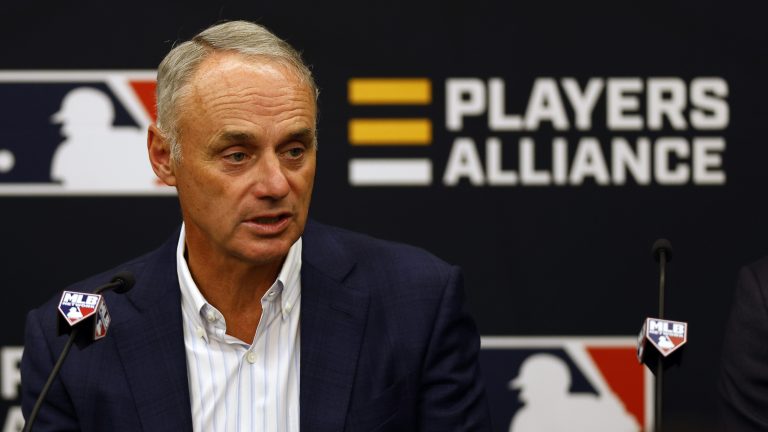MLB Owners Stall Tactics Threaten the Season
In a pursuit for leverage, MLB owners have resorted to stall tactics, PR maneuvering and a refusal to negotiate in an attempt to preserve the status quo.

The MLB owners have shown very little interest in negotiating with the Players Association. Just prior to the lockout, the owners refused to talk about core economics unless the players agreed to drop discussion of the six-year period to free agency, the arbitration system, and revenue sharing.
In other words, the owners were saying at the outset that they would refuse to bargain over those core economic issues that most concern the players.
When the players rejected this one-sided request, the owners implemented a lockout at their first opportunity when the previous CBA expired on December 1, 2021, despite this being unnecessary to continue collective bargaining. Then the owners refused to meet the players for six weeks, with the idea that prolonging the lockout would maximize the leverage of the owners as the MLB season approached and players started worrying about their paychecks.
When the two sides started discussing core economic issues, only one side, the players, were willing to make significant concessions.
The Players Association removed from the table the shortening of free agency from six to five years. They also modified their requests on revenue sharing from a $100 million reduction to $30 million.
The issues that the players remain focused on are a higher minimum salary, a higher luxury tax threshold, and more incentives for teams to avoid tanking, specifically a draft lottery that would depart from awarding draft picks based on lowest records.
Yet despite these concessions from the players, MLB owners floated counter-proposals that essentially preserved the status quo. While the Players Association asked for an increase in the minimum salary from $570,500 to $775,000, the owners initially proposed an increase to just $600,000, which would have been an actual reduction in minimum salary once inflation is factored in.
The later MLB owners’ proposal of $615,000 essentially just maintains the status quo, once adjusted for inflation.
The owners and players have discussed creating a bonus pool to reward pre-arbitration players, but the owners’ proposal for that pool includes all 0-3 year pre-arb players that meet specified qualifications (absent so-called “super twos” who qualify for arbitration) and offers only $10 million to be spread out across this player pool. That’s such a miniscule increase it would do little to nothing to alter the pay scale of pre-arb players.
Additionally, the owners reacted angrily to the Players Association proposing a $105 million bonus pool for pre-arbitration players, and they reacted angrily again when the players dropped that demand to “only” $100 million.
However, this represents another compromise from the Players Association, who appear willing to potentially settle for bonus pool money for pre-arb players instead of a reduction of arbitration eligibility from 3 to 2 years. The owners, as with other issues, are not willing to budge much at all here. Their $10 million bonus pool proposal is window dressing at best, not providing enough compensation per pre-arb player to make any meaningful change in compensation for players during their first three years.
These negotiations are one-sided in that the Players Association are the only party that is negotiating. The MLB owners, intent on giving us a slow-motion replay of previous disasters, appears intent on pushing the union to the brink, in an attempt to maintain the status quo of revenue advantages for the owners. The owners exercise extreme control over player movement, which means players can be controlled in the minors for seven years at pay that is below the minimum and living wage, courtesy of minor league players not having a union and therefore no right to collective bargaining.
MLB owners have been able to increase their power over newly drafted players by getting significant concessions from the Players Association in the previous CBAs, which have included (in the 2012 Basic Agreement) bonus pools that cap how much money drafted players can receive, as well as international bonus pools that similarly weaken bargaining rights of newly signed international players.
They also secured an increase of a year before minor league players would qualify for the Rule 5 draft, which meant (in the 2007 Basic Agreement) that players signed after the age of 19 had to wait four years, instead of three, before being eligible for the Rule 5 draft (unless protected by their team on the 40-man roster) and players signed before age 19 had to wait five years, instead of four, before being eligible for the Rule 5 Draft (unless protected by their team).
The combination of MLB control over minor leaguers, which keeps wages at poverty levels, the restriction of bargaining rights for newly drafted players, and the ongoing control over major leaguers through their first six seasons, has allowed MLB owners to leverage the cost advantages of young players over mid-level and experienced free agents. The MLB owners have secured concessions in the Basic Agreements of 2007 and 2012 that have allowed them to shift revenues from players to owners.
Once a side has secured victories in previous collective bargaining agreements, and when those victories produce tangible gains for one party—in this case the MLB owners, who have seen their revenues increase over the past decade while MLB players revenues have stagnated or declined—there is little incentive for that side to re-negotiate those changes.
The disparity in revenues between MLB owners and players became especially stark between 2015 and 2019, when MLB revenues soared from $8.2 billion in 2015 to over $10.7 billion in 2019, a 30 percent increase. During this time, player salaries decreased by 6.4 percent, with the average salary declining from $4.45 million to $4.17 million during the span of the current CBA.
The median salary has fallen from $1.65 million in 2015 to $1.15 million in 2021. Fifty-four percent of players in MLB are not yet eligible for arbitration, earning the minimum salary—a statistic which belies the notion that this is simply a battle between “millionaires and billionaires.”
Most players, even at the MLB level, are not millionaires in terms of annual compensation, with the average career of a major league player having been in steady decline from 4.79 years in 2005 to 3.71 years today. Based on a recent study using data from Spotrac, “of the 1,453 players to accrue at least one day of service time last season, 590 (40.6 percent) have made less than $1 million in career earnings. The median career earnings of that group was $357,718,” according to Travis Sawchick of FiveThirtyEight.
Something few fans are probably aware of: players pay a higher percentage of their salary as taxes compared to billionaire owners, and it’s not even close, mirroring larger trends in the U.S. Various forms of taxation consume anywhere from 40 to 50 percent of player compensation.
On the opposite end of the spectrum are billionaire owners, who benefit from a tax code that allows sports owners to depreciate the costs and “depreciation” of their franchise even as the value of that franchise increases. That’s why, according to a detailed investigative report recently carried out by ProPublica, sports owners often pay tax rates that are one-third of the amount that players pay in taxes. Pro sports owners also get their depreciation tax allowance, despite having their stadiums financed by taxpayers and despite benefitting from large-scale appreciation in team values. (Faturechi, Elliott and Simani, ProPublica, July 8, 2021).
When MLB owners have been winning for so long, they increasingly resent being asked to slow down their momentum. That’s why the current MLB owners’ strategy seems so apparent: not give an inch on any issue considered significant by the players, drag out negotiations to maximize leverage and to preserve the status quo, and declare exasperation that MLB players won’t provide more concessions (despite having secured significant concessions), and, most recently, insisting that a mediator is now necessary despite the fact that only one party is actively blocking forward progress.
The MLB owners’ call for a federal mediator to intervene in the CBA negotiations is a PR ploy designed to deflect from the one-sidedness of the negotiation process so far, and to put added public pressure on the players—who have no reason to accept the mediation given the owners intransigence and the history associated with mediation.
The use of a federal mediator in the 1994-1995 strike had no positive effects on expediting play. The only reason that baseball season was able to resume in 1995 was that a federal judge agreed with the Players Association that the owners had not negotiated with the players in good faith—which negated the owners’ strategy of declaring an impasse in negotiations and unilaterally implementing their last offer.
Though I do not think the 2022 season is in jeopardy, the owners appear oblivious to their history of power-hungry ineptitude. For the players to even win a modest set of gains in this negotiation, the owners are intent on forcing them to feel the pain of cancelled games, certainly in spring training and perhaps the regular season.

